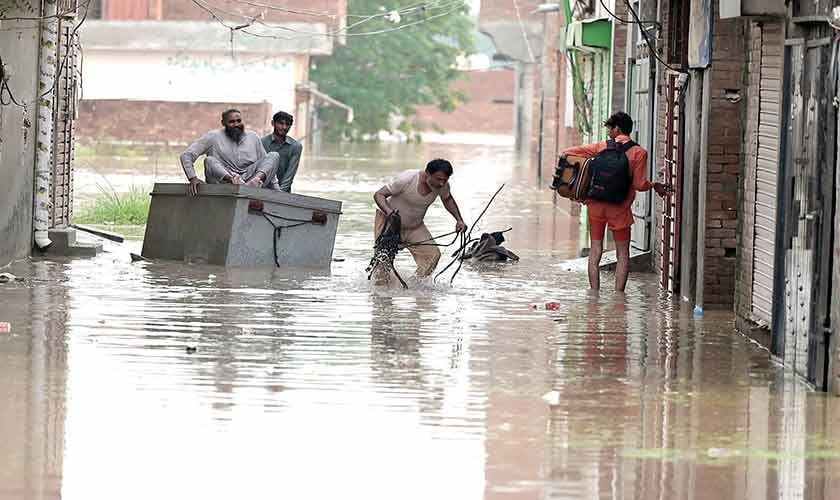In recent years, Lahore has experienced destructive rains that have ravaged the city and its suburbs, particularly the settlements along the banks of the Ravi River. This year was no different. Even a single cloudburst can decimate lives and properties, making urban flooding a recurring and severe problem.
For the Water and Sanitation Agency (WASA), this translates into a tremendous workload. After heavy showers, parts of Lahore are inundated, turning some areas into no-go zones. Emergency workers are often needed to evacuate stranded residents. Roads and streets become engulfed by water, drains overflow, and vehicles are submerged. In some places, even wading through the water becomes challenging.
Despite numerous claims and promises made by various WASA officials over the years, the crisis appears to have deepened. Ghufran Ahmed, the current WASA Managing Director, states that the agency has launched a host of initiatives to tackle the issue. “Fifty-two schemes have been chalked out, with an estimated cost of Rs 25.06 billion,” he revealed in an interview with TNS.
Of these schemes:
– Ten focus on rainwater storage and are budgeted at Rs 7.4 billion.
– Twenty-six projects aim to replace old sewers that have outlived their lifespan, costing Rs 9.16 billion.
– Six schemes involve replacing 55 outdated machines, with a budget of Rs 1.70 billion.
– The construction of the Haji Camp Drain, another critical project, is budgeted at Rs 4.10 billion.
Ahmed also spoke about an extensive development program for Lahore that is currently underway, covering 252 schemes with a budget of Rs 41.35 billion. So far, Rs 21.05 billion have been allocated for this program.
### Challenges and Strategic Projects
The challenges faced by WASA are immense. According to Mudasser Javed, Director of Planning and Engineering at WASA, Lahore’s infrastructure is fragile. Rapid urbanization has placed enormous pressure on the city’s drainage system.
To address these challenges, a major Rs 49.27 billion project has been designed. It seeks to build a trunk sewer aligned with Lahore’s Master Plan. The new sewer will stretch 28 kilometers, ranging from 5 to 12 feet in width, and will utilize modern trenchless technology. Additionally, a disposal station with a capacity of 600 cusecs is part of the project.
This project has been submitted to the Executive Committee of the National Economic Council (ECNEC) for approval, with funding expected from the Asian Infrastructure Investment Bank.
### Funding and Administrative Issues
Securing financing for development projects remains a significant hurdle. Documents from WASA reveal that the monsoon grant has been frozen at Rs 425 million since 2017, making routine drain maintenance difficult. WASA has requested an increase in this grant to Rs 1 billion.
Several other issues also require urgent attention:
– **Overlapping Jurisdictions:** Multiple agencies are currently responsible for water supply, sewerage, and drainage. This overlap leads to confusion and delays. WASA has recommended that all these services be delegated to a single agency.
– **Solid Waste Disposal:** The disposal of solid waste into drains and sewers exacerbates flooding. Strict enforcement is necessary to curb this practice.
Ahmed points out that Lahore’s 195 parks and open spaces are located on high ground, preventing them from storing rainwater. To address this, WASA has proposed lowering these parks so they can function as holding spaces.
### Initiatives Underway
WASA has initiated several efforts to improve the city’s flood resilience:
– **Rainwater Storage Projects:** Of the 52 schemes mentioned earlier, 10 focus on enhancing rainwater storage.
– **Road Gradient Improvements:** Many roads have poorly designed gradients, resulting in water puddling and stagnation. Road agencies have been instructed to correct these issues by creating proper catch pits.
– **Sanitation and Stray Cattle:** Stray cattle contribute to sanitation problems and need to be relocated.
Recently, WASA began lowering the ground levels of 140 parks—66 categorized as high priority, 43 medium priority, and 32 low priority. So far, work has been completed in 13 parks, is ongoing in 7, and 120 are pending. The plan is to keep these parks two feet below road level to allow rainwater to flow into them. Additionally, greenbelts are being lowered; out of 54 identified, 41 are high priority, 10 medium, and 3 low.
These efforts have started yielding results. For example:
– At Gol Bagh Park in Shadbagh, lowering the ground level by one foot reduced ponding from six inches lasting two hours to three inches lasting just one hour.
– In Subhan Park, Tajpura, lowering the ground level by two feet eliminated ponding altogether, whereas previously six inches of water would stand for three hours.
### WASA’s Drainage Infrastructure and Machinery
WASA oversees a comprehensive drainage system comprising several large drains:
– **Shalimar Escape Channel:** 13.44 kilometers long, carrying up to 1,000 cusecs.
– **Upper Chhota Ravi Drain:** Almost 5 kilometers long, capacity of 1,480 cusecs.
– **Lower Chhota Ravi Drain:** 5 kilometers long, capacity of 100 cusecs.
– **Cantt Drain:** Nearly 29 kilometers long, with a capacity for 1,340 cusecs.
– **Sattu Katla Drain:** 17 kilometers long, carrying up to 800 cusecs.
– **Shahdara Drain:** 7 kilometers long, capacity of 260 cusecs.
– **Charrar Drain:** 18 kilometers long, capacity of 800 cusecs.
To manage these drains effectively, WASA operates a large fleet of mobile machinery. This includes 40 suction machines, 56 dump trucks, 41 jet machines, 3 cranes, 24 water bowsers, 14 excavators, 134 dewatering sets, and 95 backhoe loaders and trolleys. Ahmed confirms that additional machines are being procured.
### Master Plan 2050: A Vision for Flood Control
At the heart of WASA’s flood mitigation efforts is the Master Plan 2050, which takes into account Lahore’s present conditions and projected future, including vertical expansion.
Key elements of the plan include:
– Separating sewage from stormwater to prevent system overload.
– Eliminating the use of lift stations.
– Utilizing stormwater channels designed for greater effectiveness and climate resilience.
– Converting drains into waterfront recreational areas during the dry season to beautify the city.
– Reducing air pollution caused by poor drainage.
The area covered by WASA is set to expand from 248 square kilometers, currently serving 8.7 million people, to 477 square kilometers, projected to serve up to 23.3 million people by 2050. Improved sewage treatment will protect groundwater, enhance aquatic life, and create more livable communities.
### Expert Opinions and Recommendations
Urban planner Qaswar Abbas highlights several contributing factors to Lahore’s flooding woes, including local depressions in roads, unfinished road cuts, potholes, raised green belts, and missing gratings. He notes that outdated or missing infrastructure and the mixing of stormwater with sewage exacerbate the problem.
To rectify this, Abbas suggests that WASA should:
– Increase rainwater storage capacity in underground tanks and tunnels.
– Utilize low-lying grounds and greenbelts more effectively.
– Promote rainwater harvesting.
He adds that while relevant bylaws already exist, their stricter enforcement is crucial for meaningful progress.
—
Lahore’s battle against urban flooding is complex and multifaceted, requiring coordinated efforts, significant investment, and long-term planning. With ongoing projects and the ambitious Master Plan 2050, there is cautious optimism that the city can better withstand future monsoon challenges and improve the quality of life for its residents.
https://www.thenews.com.pk/tns/detail/1345142-flood-money

